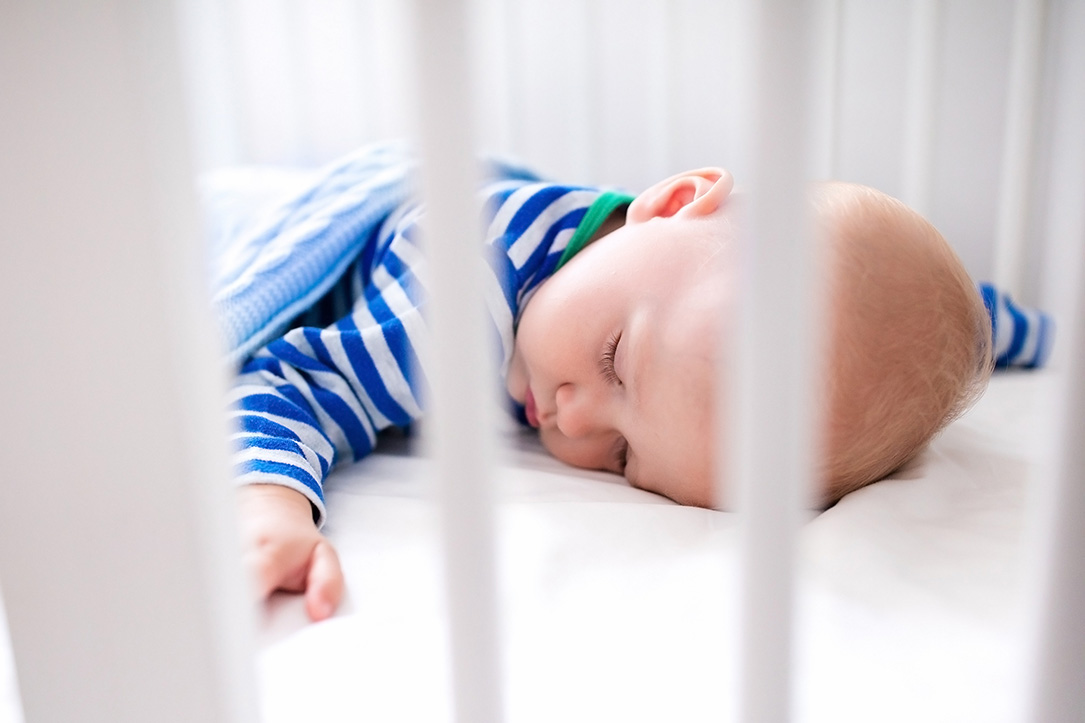Whether you are a first time parent, a friend of an expectant mother, or having your fifth baby, it’s common (and encouraged) to catch up on the latest sleep studies and newborn sleep advice. Sleep deprivation may already be expected by every parent, but it doesn’t mean you and your baby can’t still have long naps and sweet dreams.
Want to know the latest advice on when babies can sleep on their stomachs and how they can do it safely? Read on to learn more!
Baby Sleep Milestones
A baby will hit a few different sleep milestones throughout their first year of life. Parents should make certain adjustments along the way. Read on below to learn more common sleep milestones your little one will hit in its first 12 months of age. And check out A Parents’ Guide to Helping Children Sleep to learn even more about helping your baby get the sleep it needs.
Fewer Night Feedings and Longer Sleep Times
A newborn baby will sleep in three to four hour stretches for the first few months of its life. Your newborn should be sleeping between 12 to 18 hours a day, and will mainly only wake up when they’re hungry. According to the Cleveland Clinic, new parents should not let their babies sleep longer than five hours at a time in the first month and half.
You’ll notice your baby sleep for longer and longer stretches as he or she gets older. Between 4-6 months of age, your baby could be sleeping 5 to 6 hours in a row. When your baby hits about 2 months of age, you can start encouraging them to sleep more at night by keeping the lights dim and stimulation low during nighttime feedings. When your baby is about one year old, you can also try introducing a security object like a blanket to your baby’s crib to help them self-soothe after waking up at night.
Rolling Over Both Ways
Your baby may also start rolling over at night somewhere around 4 months of age. You can let your baby stay in the sleeping position they roll into once they are able to roll over. But, make sure you put your baby to sleep on their back. You should always start your baby on their back at bedtime or naptime. At around 6 months of age, you can transition your baby into their own room. Prior to 6 months, your baby should sleep in the same room as you (but in their own crib or bassinet).
Which Position is Best for Babies to Sleep In?
It is safest for babies to sleep on their backs. In fact, the American Academy of Pediatrics (AAP) recommends this position. Place your baby on its back on a flat and firm sleep surface in a bassinet or crib before bed. Check out our Crib Mattress Buying Guide for help choosing a bed for your newborn.
Back sleeping is the safest of all baby sleeping positions because it can reduce the risk of sudden infant death syndrome (SIDS). According to the National Institutes of Health (NIH) it can also help babies clear fluids from their airways more easily, because babies’ bodies are built differently from ours. So, you don’t need to worry about your baby choking on spit up while back sleeping.
If you’re concerned that back sleeping is giving your baby a flat spot on the back of his or her head, encourage tummy time when your baby is awake. But do not encourage your infant to sleep on his or her stomach to combat a flat spot. The spot should resolve on its own.

Is it Safe for Babies to Sleep on Their Stomach?
Letting your infant sleep on its stomach is not encouraged. It increases the risk of suffocation, SIDS, and Sudden Unexpected Infant Death (SUID). Place your baby on his or her back at bedtime and naptime. Read on below to learn more about SIDS and SUID.
The Risk of SIDS
According to the NIH, SIDS is the sudden, unexplained death of a baby under one year old. SIDS deaths do not have a known cause, even after investigation. SIDS is sometimes called crib death because it often occurs when the baby is sleeping, and it is the leading cause of death among babies from 1 month to 1 year old. Most SIDs deaths occur when babies are 4 months old or younger. Babies are at higher risk for SIDs if they sleep on their stomachs, sleep on soft surfaces or with loose bedding, overheat at night, co-sleep with parents, or are exposed to cigarette smoke.
SUID
SUID is a term used to define the sudden and unexpected death of a baby under one year old. SUID includes all sudden and unexpected deaths, and encompasses deaths from SIDs. Unlike SIDS, SUID encompasses other sleep-related infant deaths like those from suffocation or strangulation.
When Can Babies Sleep on Their Stomach?
Babies can sleep on their stomachs when they are able to roll over to their stomach and back on their own. In those cases, if your baby rolls over on its own at night it is safe to let them keep stomach sleeping until they wake up. But you should continue to place your babies on their backs when it is time to put them back to sleep at night or for a nap.
Some studies suggest that tummy sleeping could help certain babies with bad acid reflux. But you need to consult with a pediatrician about risk factors and safe sleep recommendations before placing a baby on his or her stomach at night. In general, most babies who can not roll over should not stomach sleep without observation by a healthcare provider.
How to Keep Your Baby Safe While Sleeping on Their Stomach
There are a few different things you can do before your baby’s first birthday to ensure he or she is in a safe sleep environment. These tips are especially helpful if your child tends to roll over and sleep on its stomach during the night. Read on below to learn about the best sleep practices for your child, and check out our Everything You Should Know About Your Baby’s Sleep article for even more info.
Stop Swaddling or Switch to Sleep Sacks
Swaddling your child in a blanket could be a suffocation or strangulation risk if your baby moves around a lot at night. Most babies will move around and startle often in their sleep, so having them wrapped in a blanket that they could get stuck in or that could cover their faces when you are not watching is dangerous.
If your baby can’t sleep without being swaddled, consider switching over to a sleep sack. These sacks are like wearable blankets that keep your baby’s arms free and give them space to roll and kick when they need to.
Keep the Crib (or Pack n Play) Free of Any Objects During Sleep Periods
You should also keep your baby’s crib or playpen free of loose objects during naptime and bedtime. At about one year, introducing one comfort object is safe. Before then, your baby could get stuck under things like bumper pads and loose blankets, increasing the risk of suffocation. Your baby’s sleep surface should be firm and level, and you should only put a fitted sheet on it. Blankets, toys, and loose sheets should not be in your baby’s sleep area.
Offer a Pacifier
Pacifiers can reduce SIDs risks in babies. Offer your baby a pacifier after breastfeeding is well established (if you are breastfeeding) or, if you are not breastfeeding, as soon as you’d like to. Do not attach the pacifier to clothing, toys, or blankets and do not coat it in anything like honey. If your baby does not want a pacifier or it falls out of his or her mouth during sleep, that is alright. There is no need to wake your child up to replace it or force your baby to use a pacifier.
Set the Thermostat Accordingly
Babies can overheat at night if they are wearing too many clothes for the room temperature. Set the thermostat between 68 and 72 degrees to keep your baby from overheating or getting too cold at night. Preventing overheating can reduce the risk of SIDS.
Avoid Exposure to Secondhand Smoke
Exposure to cigarette smoke in the womb or secondhand in the house or car can increase the risk of SIDS. Avoid exposing your child to secondhand smoke, as it can increase the risk of health problems in addition to SIDS.

